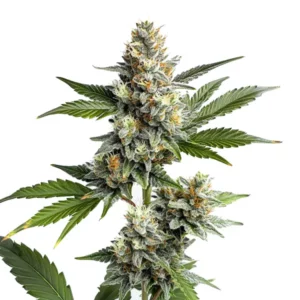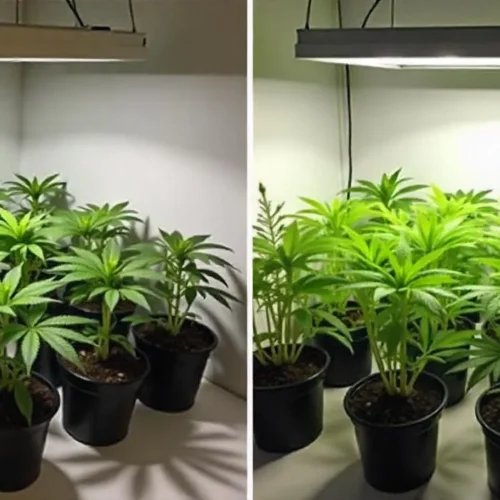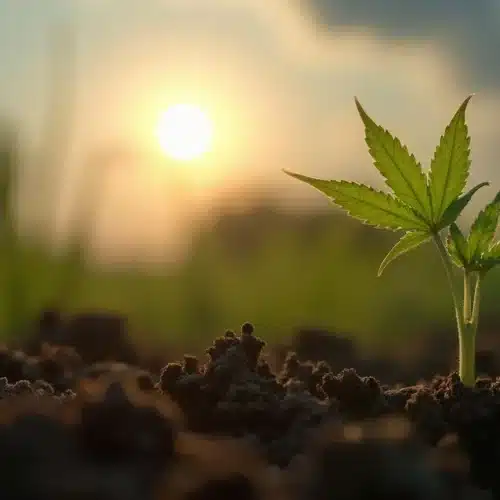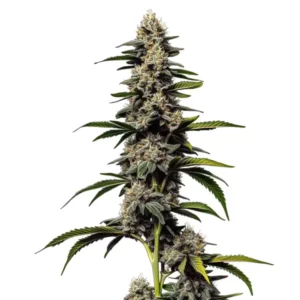A variegated plant, like a variegated marijuana plant, has leaves with multiple colors, usually including patterns of white, yellow, or light green in addition to the standard green. This color variation is due to differences in pigmentation within the leaves, often because of genetic mutations or viral infections that affect the distribution of chlorophyll and other pigments. Variegated plants, including variegated cannabis, are popular in gardening and landscaping for their unique and decorative appearance. They can occur naturally or be selectively cultivated for their striking visual appeal.
What Causes Variegated in Cannabis Plants?
Variegation in cannabis plants, as in other plant species, is primarily caused by genetic mutations affecting chlorophyll production or distribution. Chlorophyll is responsible for the green coloration in leaves, and variegation occurs when there are changes in chlorophyll levels or distribution within leaf tissues. These mutations can arise spontaneously or through breeding, resulting in areas of the leaf, such as variegated cannabis leaves, that lack chlorophyll (appearing white or yellowish) interspersed with normal green areas.
Recommended Strains
Permanent Marker
 THC: 32% - 34%
THC: 32% - 34% Type of seed: Feminized
Type of seed: Feminized Phenotype: Mostly Hybrid
Phenotype: Mostly Hybrid Day to flower: 8 - 10 weeks
Day to flower: 8 - 10 weeks
Permanent Marker Auto
 THC: 32% - 34%
THC: 32% - 34% Type of seed: Autoflowering
Type of seed: Autoflowering Phenotype: Mostly Hybrid
Phenotype: Mostly Hybrid Day to flower: 7 - 9 weeks
Day to flower: 7 - 9 weeks
The specific mutations that cause variegation can vary, but they generally affect the function of chloroplasts within the plant cells. This condition is usually stable within a plant, meaning that the variegated pattern persists through growth and development. While variegation can be visually striking and interesting, it can also affect the plant’s ability to photosynthesize effectively, potentially impacting its growth and vigor compared to fully green plants.
Environmental conditions contribute to the variegation seen in cannabis plants. Factors like light intensity and temperature play crucial roles in influencing leaf pigmentation. Increased light exposure can induce photobleaching, where chlorophyll breakdown leads to white tips on leaves and flowers. Interestingly, reduced chlorophyll content in flowers can enhance the curing process by minimizing any harsh flavors in the final product.
Promos & Deals
Pros And Cons of Variegated Cannabis Plant
Varied cannabis plants are not only visually striking; They also exhibit potential for increased cannabinoid and terpenoid production. There is some research on certain genetics where it was revealed that variegated specimens had elevated levels of cannabidiol (CBD), and terpenes compared to their non-variegated counterparts (with normal chlorophyll contents). This study suggested that chlorophyll reduction could redirect metabolic resources toward cannabinoid and terpenoid production, thereby increasing yields.
Besides their enhanced biochemical production, variegated cannabis plants might possess improved resistance against pests and diseases. Some growers have observed reduced susceptibility to aphids, spider mites, and powdery mildew, although scientific confirmation is lacking.
However, variegated cannabis plants come with drawbacks. They generally exhibit lower vigor and yield compared to non-variegated plants due to reduced chlorophyll, which impairs photosynthesis critical for growth and productivity. Variegated cannabis seeds often require extra care and precise environmental conditions, as the resulting plants are more sensitive to stress. Their variegated tissues are particularly sensitive to intensive feeding, necessitating a lighter feeding regimen. While they may not be ideal for large-scale cultivation, variegated cannabis seeds remain an excellent choice for hobbyists or personal use. For example, strains like Bubble Gum Sherb offer unique aesthetics and flavor profiles that appeal to growers seeking something special and visually distinctive.

Tobacco Mosaic Virus and Variegated Cannabis Plants
Variegation in cannabis can also be caused by pathological factors. In such cases, the variegation doesn’t display specific patterns. One of the viruses responsible for pale color markings on cannabis leaves is the Tobacco Mosaic Virus (TMV). TMV results in uneven yellow stripes on the leaves, but unlike genetically induced variegation, this one isn’t harmless. TMV also leads to leaf twisting and curling.
Extensive research is needed regarding TMV in cannabis, as many growers deny its presence in these plants. Variegated cannabis may attract attention due to its unique appearance, but it lacks any advantages over normal plants. In fact, it has the disadvantage of reduced chlorophyll, which negatively affects photosynthesis. Ultimately, there’s no way to treat variegation in cannabis because altering a plant’s genetic makeup is impossible. Have you ever encountered variegated cannabis plants? Share your experience by leaving a comment below.
How Is the Resin On the Plants?
Regarding the resin produced by variegated cannabis plants, there are several aspects to consider:
Resin Production: The ability of a variegated plant to produce resin may be affected depending on the degree of variegation and its cause. If variegation is mild and does not significantly affect plant health, resin production can be relatively normal. However, in severe cases where photosynthesis is compromised due to loss of chlorophyll, resin production may decrease.
Resin Composition: The composition of the resin, in terms of cannabinoids and terpenes, can also vary. There are no extensive studies detailing specific changes in the chemical composition of resin in variegated plants, but it is possible that there are variations in the proportion of these compounds due to stress on the plant or changes in metabolism.
Resin Quality: Resin quality can be similar to that of non-variegated plants if the variegated plant is healthy and receives proper care. However, if variegation negatively affects plant health, resin quality could be compromised.
Resin Appearance: The visual appearance of resin may not be significantly affected by variegation, although the overall health of the plant may influence the number and density of trichomes (the resin-producing glands).

Aroma and Flavor
Aroma: Variegation in cannabis plants does not necessarily directly affect the production of terpenes, which are the compounds responsible for aroma. However, if variegation is caused by stress or nutritional deficiencies, this could potentially alter the plant’s terpene profile. Variegated cannabis plants may have a similar aroma to non-variegated plants, but there is variability depending on the underlying cause of the variegation.
Flavor: Like aroma, the flavor of variegated cannabis plants can be indirectly affected by stress or conditions that cause variegation. If the plant is healthy and well cared for, the flavor can be very similar to that of non-variegated plants. However, if variegation is a symptom of health problems in the plant, this could lead to a less desirable flavor.
Bud production and size
Due to reduced photosynthesis, variegated plants often experience slower growth. This can affect the overall development of the plant, including the formation and maturation of buds. The combination of lower photosynthetic capacity and slowed growth can result in reduced bud production and smaller bud size. Buds may be smaller, less dense, and contain fewer cannabinoids and terpenes.
How to promote cannabis plant variegation?
To promote more variegation in your cannabis plants, aim for increased sunlight without direct exposure. Start in a spot with indirect light and gradually move it to a brighter location. It’s also beneficial to regularly trim away leaves that lack variegation.
Is variegation bad for cannabis?
Variegated cannabis, which displays a mix of colors in its leaves, is often a topic of debate among growers. While it can be visually striking, a variegated weed plant might indicate underlying issues. This unique leaf pattern can result from genetic mutations, nutrient deficiencies, or environmental stressors. While some growers appreciate the aesthetic appeal, variegated cannabis plants may experience reduced photosynthetic efficiency, potentially leading to lower yields and slower growth. Therefore, variegation in cannabis is generally seen as a sign of plant stress rather than a beneficial trait.

FAQs
What causes variegation in cannabis plants?
Variegation in cannabis plants is primarily caused by genetic mutations that disrupt chlorophyll production or distribution, leading to leaves with white, yellow, or light green patterns. Environmental stress, such as light intensity or viral infections like Tobacco Mosaic Virus (TMV), can also induce variegated patterns. While visually striking, this condition may reduce the plant’s photosynthetic efficiency.
Are variegated cannabis plants less potent or productive?
Variegated cannabis plants can be less productive due to reduced chlorophyll, which limits photosynthesis and slows growth. This may lead to smaller buds and lower yields. However, some variegated strains show potential for enhanced cannabinoid and terpene production. With proper care and stable genetics, resin quality and flavor can still be comparable to non-variegated plants.
Can variegation be encouraged in cannabis plants?
While most variegation is genetic and not easily induced, some growers attempt to promote it by increasing light exposure gradually or trimming non-variegated leaves. However, intentional variegation may stress the plant and affect its health. It’s generally more reliable to select variegated genetics rather than trying to force the trait through environmental manipulation.


















